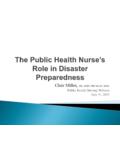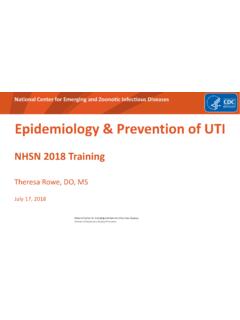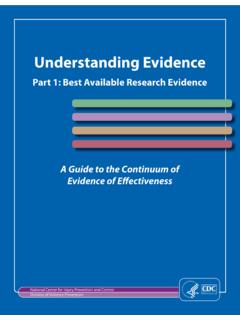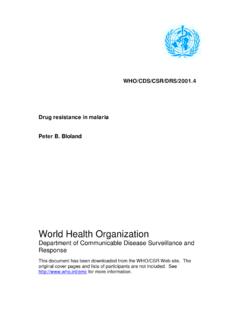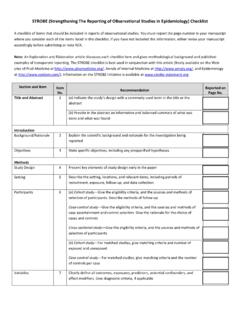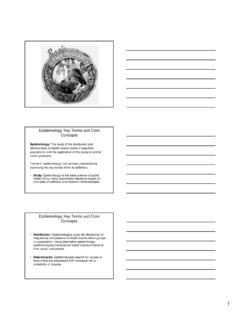Transcription of HEALTH EVIDENCE NETWORK SYNTHESIS REPORT 67
1 Daisy Fancourt | Saoirse FinnHEALTH EVIDENCE NETWORK SYNTHESIS REPORT 67 What is the EVIDENCE on the role of the arts in improving HEALTH and well-being? A scoping reviewWorld HEALTH OrganizationRegional Office for EuropeUN City, Marmorvej 51, DK-2100 Copenhagen , DenmarkTel.: +45 45 33 70 00 Fax: +45 45 33 70 01 Email: EVIDENCE NETWORK SYNTHESIS REPORT 67 What is the EVIDENCE on the role of the arts in improving HEALTH and well-being?A scoping reviewDaisy Fancourt | Saoirse FinnAbstractOver the past two decades, there has been a major increase in research into the effects of the arts on HEALTH and well-being, alongside developments in practice and policy activities in different countries across the WHO European Region and further afield.
2 This REPORT synthesizes the global EVIDENCE on the role of the arts in improving HEALTH and well-being, with a specific focus on the WHO European Region. Results from over 3000 studies identified a major role for the arts in the prevention of ill HEALTH , promotion of HEALTH , and management and treatment of illness across the lifespan. The reviewed EVIDENCE included study designs such as uncontrolled pilot studies, case studies, small-scale cross-sectional surveys, nationally representative longitudinal cohort studies, community-wide ethnographies and randomized controlled trials from diverse disciplines. The beneficial impact of the arts could be furthered through acknowledging and acting on the growing EVIDENCE base; promoting arts engagement at the individual, local and national levels; and supporting cross-sectoral , MEDICINE IN THE ARTS, CULTURE, ARTS IN HEALTHA ddress requests about publications of the WHO Regional Office for Europe to: PublicationsWHO Regional Office for EuropeUN City, Marmorvej 51DK-2100 Copenhagen , DenmarkAlternatively, complete an online request form for documentation, HEALTH information, or for permission to quote or translate, on the Regional Office website ( ).
3 ISSN 2227-4316 ISBN 978 92 890 5455 3 World HEALTH Organization 2019 Some rights reserved. This work is available under the Creative Commons Attribution-NonCommercial-ShareAlike IGO licence (CC BY-NC-SA IGO; ). Under the terms of this licence, you may copy, redistribute and adapt the work for non-commercial purposes, provided the work is appropriately cited, as indicated below. In any use of this work, there should be no suggestion that WHO endorses any specific organization, products or services. The use of the WHO logo is not permitted. If you adapt the work, then you must license your work under the same or equivalent Creative Commons licence.
4 If you create a translation of this work, you should add the following disclaimer along with the suggested citation: This translation was not created by the World HEALTH Organization (WHO). WHO is not responsible for the content or accuracy of this translation. The original English edition shall be the binding and authentic edition . Any mediation relating to disputes arising under the licence shall be conducted in accordance with the mediation rules of the World Intellectual Property citation. Fancourt D, Finn S. What is the EVIDENCE on the role of the arts in improving HEALTH and well-being? A scoping review. Copenhagen: WHO Regional Office for Europe; 2019 ( HEALTH EVIDENCE NETWORK (HEN) SYNTHESIS REPORT 67).
5 Cataloguing-in-Publication (CIP) data. CIP data are available at , rights and licensing. To purchase WHO publications, see To submit requests for commercial use and queries on rights and licensing, see Third-party materials. If you wish to reuse material from this work that is attributed to a third party, such as tables, figures or images, it is your responsibility to determine whether permission is needed for that reuse and to obtain permission from the copyright holder. The risk of claims resulting from infringement of any third-party-owned component in the work rests solely with the disclaimers. The designations employed and the presentation of the material in this publication do not imply the expression of any opinion whatsoever on the part of WHO concerning the legal status of any country, territory, city or area or of its authorities, or concerning the delimitation of its frontiers or boundaries.
6 Dotted and dashed lines on maps represent approximate border lines for which there may not yet be full mention of specific companies or of certain manufacturers products does not imply that they are endorsed or recommended by WHO in preference to others of a similar nature that are not mentioned. Errors and omissions excepted, the names of proprietary products are distinguished by initial capital reasonable precautions have been taken by WHO to verify the information contained in this publication. However, the published material is being distributed without warranty of any kind, either expressed or implied. The responsibility for the interpretation and use of the material lies with the reader.
7 In no event shall WHO be liable for damages arising from its use. The named authors alone are responsible for the views expressed in this in CopenhageniiiCONTENTS Abbreviations ..iv Acknowledgements ..v Summary ..vii 1. Introduction ..1 Background ..1 Methodology ..6 2. Results ..7 Prevention and promotion ..9 Management and treatment ..29 3. Discussion ..51 Strengths and limitations of the review ..51 Summary of findings ..52 Policy considerations ..55 4. Conclusions ..57 References ..58 Annex 1. Search strategy ..128ivABBREVIATIONSASD autistic spectrum disorderCVD cardiovascular diseasesLGBTQ lesbian, gay, bisexual, transgender and queerPD Parkinson s diseasePTSD post-traumatic stress disordervACKNOWLEDGEMENTSThe authors would like to acknowledge Dr Simon Chaplin from the Wellcome Trust for providing the introduction to the Cultural contexts of HEALTH project that led to the writing of this REPORT , and also the Wellcome Trust for funding Daisy Fancourt through a Wellcome Research Fellowship (205407/Z/16/Z).
8 This REPORT has been produced with the financial assistance of the Wellcome Trust. The views expressed herein can in no way be taken to reflect the official opinions of the Wellcome FancourtAssociate Professor and Wellcome Research Fellow, Institute of epidemiology and HEALTH Care, University College London, London, United KingdomSaoirse FinnVisiting Researcher, Institute of epidemiology and HEALTH Care, University College London, London, United KingdomPeer reviewersNorma DaykinProfessor, Tampere University, Tampere, FinlandLiisa LaitinenProject Planner, Taikusyd n Arts & HEALTH Coordination Centre, Turku University of Applied Sciences, Turku, FinlandKai LehikoinenDirector of Research Center.
9 Center for Educational Research and Academic Development in the Arts (CERADA) and Vice Director, ArtsEqual, University of the Arts, Helsinki, FinlandVictoria TischlerProfessor of Arts and HEALTH , University of West London, London, United KingdomviEditorial team, WHO Regional Office for EuropeDivision of Information, EVIDENCE , Research and InnovationNils FietjeResearch Officer, EVIDENCE for HEALTH and Well-being in ContextAndrea ScheelConsultant, EVIDENCE for HEALTH and Well-being in ContextShanmugapriya UmachandranConsultant, EVIDENCE for HEALTH and Well-being in ContextHealth EVIDENCE NETWORK (HEN) editorial teamKristina Mauer-Stender, Acting DirectorTanja Kuchenm ller, Editor in ChiefRyoko Takahashi and Tarang Sharma, Series EditorsTyrone Reden Sy, Managing EditorKrista Kruja, ConsultantJane Ward, Technical EditorThe HEN Secretariat is part of the Division of Information, EVIDENCE , Research and Innovation at the WHO Regional Office for Europe.
10 HEN SYNTHESIS reports are commissioned works that are subjected to international peer review, and the contents are the responsibility of the authors. They do not necessarily reflect the official policies of the Regional issueSince the beginning of the 21st century, there has been a major increase in research into the effects of the arts on HEALTH and well-being. This has occurred alongside developments in practice and policy activities in different Member States across the WHO European Region and further afield. However, because of a lack of awareness of the EVIDENCE underpinning these activities, there has been little consistency in policy development across different Member States in the Region.










